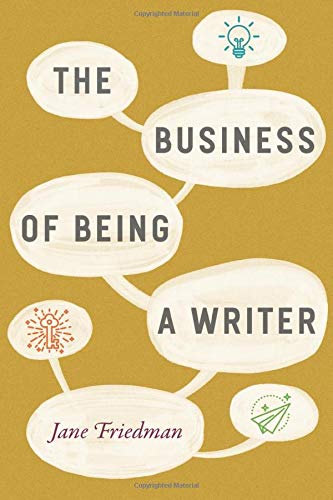 Writing is a solo endeavor rife with complexities; we’re artists on one hand and entrepreneurs on the other. For every piece we write, we have to come up with a pitch or a logline to sell our work. Yet, how does an author find the balance between cultivating their craft and marketing for the masses? Usually, it’s the agent’s or editor’s job to give artists a strategy for handling this duality, but what if you’re new to the business and you haven’t reached those milestones? Or what if your book has gone to press and those feedback channels have migrated to other clients? Jane Friedman’s The Business of Being a Writer (University of Chicago Press 2018) tackles these conundrums by painting a realistic picture of what writers need to master for success—from brainstorming story ideas to branding a website—and the mindset necessary to sustain those achievements over a lifetime.
Writing is a solo endeavor rife with complexities; we’re artists on one hand and entrepreneurs on the other. For every piece we write, we have to come up with a pitch or a logline to sell our work. Yet, how does an author find the balance between cultivating their craft and marketing for the masses? Usually, it’s the agent’s or editor’s job to give artists a strategy for handling this duality, but what if you’re new to the business and you haven’t reached those milestones? Or what if your book has gone to press and those feedback channels have migrated to other clients? Jane Friedman’s The Business of Being a Writer (University of Chicago Press 2018) tackles these conundrums by painting a realistic picture of what writers need to master for success—from brainstorming story ideas to branding a website—and the mindset necessary to sustain those achievements over a lifetime.
Jane Friedman is a columnist with Publishers Weekly and a professor with The Great Courses educational site. She is also a former editor for F+W Media and has over 20 years’ experience in the publishing industry as a writer, marketer, and business strategist. In addition, she’s written several nonfiction books for writers, including Publishing 101, What Editors Do, Literary Publishing in the 21st Century, and the Beginning Writer’s Answer Book. Her latest work pulls all of that expertise into a handy guide, helping fiction and nonfiction writers discover which income stream best suits their strengths, how to set realistic goals, and how to market themselves.
To do this, she splits the book into five sections—establishing a writing career, understanding the publishing industry, getting your book published, laying the foundation for entrepreneurship, and making money as a writer. In the first section, she takes a brutally honest approach to help you discover what will satisfy your artistic goals, what will grow your audience, and what will earn you money.
She doesn’t downplay the cruel realities of the business like the inevitability of rejection and the sheer number of competitive manuscripts submitted each year. Instead, she encourages writers to use that information as a tool and combat the odds with strong branding elements. She also discusses the concept of continued education and building relationships with other authors through “literary citizenship” (i.e. positive participation within your writing community).
In the section on the publishing industry, Friedman covers the typical paths to publication and the payment/royalty matrixes as they currently exist in the areas of trade, magazine, digital, and literary media. She warns that even the most talented writers should not wait for the publisher to develop a vision and marketing strategy for their work. Savvy authors should complete this task prior to submission and take an active role in shaping their own presence. Friedman explores the specific methods of achieving those publicity strategies in the following chapters.
The third portion of the book is by far the longest and covers the nagging questions every writer has about how to attract an agent or editor. She believes it all starts with understanding where your book fits in the marketplace. Is it commercial, literary, or upmarket fiction? If it’s nonfiction, have you identified your audience and established a platform for reaching them? To advertise your product, publishers must be able to identify a comparable, successful work. Freidman walks you through how to discover your niche and examines the basic materials a writer needs to acquire an agent, such as a query letter, synopsis, or nonfiction book proposal.
You can find samples of these submission materials on her companion website. She then addresses the benefits and pitfalls of self-publishing as well as the earning potential for short stories, poetry, and blogs. In addition, Friedman includes several appendixes that provide contract lingo for writers, explanations of legal issues like copyright protection, lists of in-depth reference guides to publication, and more.
The fourth section takes a deep dive into marketing and building the author’s platform, the importance of social media in our growing technological landscape, and the basics of online book launches. The fifth and final section explores the different options available to writers for making money such as freelance editing, teaching, online education, grants, fellowships, corporate media writing, and crowdfunding donations.
Friedman maintains a conversational tone throughout, which keeps the work from becoming an academic textbook. Yet, at 311 pages, the book doesn’t lend itself to an overnight read. The practicality of her advice feels more like a coach or a career advisor. Therefore, it’s better to read each section as it pertains to your current needs.
Overall, Friedman gives sound advice about the publishing industry without insisting there’s only one avenue for success. Although learning about the business of writing may not make up for mediocre work, she believes it will reduce frustration and lead to a more productive career. Even though this book provides a less comprehensive look at publication than her novel Publishing 101, Friedman’s explanation of the many different business ventures available to the modern writer gives readers a clear picture of the options for sustaining a lifelong career.
In fact, it’s what makes Friedman’s work more valuable than the average how-to book on proposal writing, querying, or creating an author platform. She highlights how the writing industry has changed over the years and outlines what media and publishing professionals expect moving forward, as well as what readers might demand from authors as the industry evolves. As a result, The Business of Being a Writer is more than a list of action steps, it’s a roadmap that creatives can use to develop an area of expertise and build a truly transcendent brand. Every writer should read this book.
If you’re interested in The Business of Being a Writer, you may be thinking about when it’s all about the money—and when it’s not.
